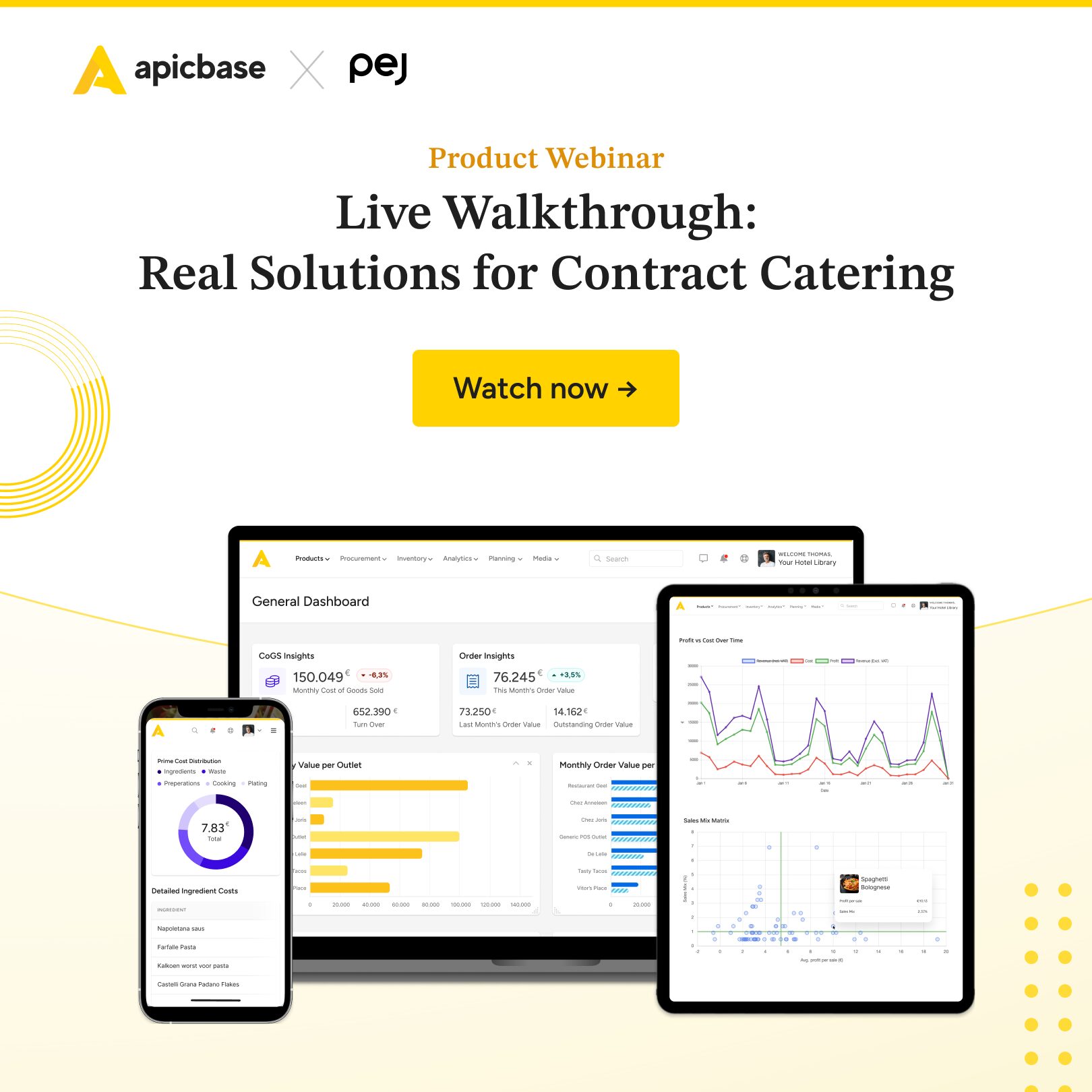Contrary to what you’ve been led to believe, upending your processes and investing in AI-driven FoH and BoH tech ARE NOT the home stretch of your digital transformation journey.
For a lot of F&B operators, these upgrades are the enablers of digital transformation.
What’s missing is your driver — a digital company culture.
This cultural shift is particularly difficult in the F&B industry; a human-driven industry if there ever was one. And I don’t expect this to change anytime soon — there’s no AI or tool out there that can efficiently remove the human factor from the equation here [and there won’t be for decades to come].
But the times are a-changin’, and you need to focus on data and automation to grow your business. That’s why you need to ‘break’ that ‘we’ve-always-done-it-like-this’ mindset that’s slowing down your DT progress.
Only then will you be able to grow your bottom line faster than your competitors… and avoid being swallowed up by them.
Recommended reading: An In-Depth Overview of an AI-Powered Foodservice Industry
To help you do that faster, this post will tackle corporate culture problems that are [likely] preventing you from moving ahead with your F&B digital transformation. You’ll get the scoop on:
- what’s behind the ‘digital culture’ mindset [& why you’re maybe not there yet]
- 3 ways in which your conventional company culture is hamstringing your DT efforts
- 4 culture and organisational shifts you need to make to drive digital disruption
- a ‘secret’ weapon that can help you upgrade your tech without losing sight of your culture
First up — what digital corporate culture really is [and how to test if you’ve got one].

Get The Ultimate Guido to Digital Transformation in the Restaurant & Foodservice Industry
You’ll get a top-level overview of how AI can help you transform your F&B operation.
Is Your Corporate Culture a Digital Culture?
First, let’s get clear on what digital corporate culture actually is.
What is a Digital Culture
Digital culture is a concept that describes how tech and the internet are shaping the way humans interact. It’s a result of endless disruptive innovation and focuses on the relationship between humans and technology; how we use it and how we adapt to it.
This is a very woo-woo definition, but in the context of business and digital transformation, the line about adaptation is crucial.
You see…
Adopting new technology is just the first step in the process of making your F&B operation digitally forward. It’s a step toward digitalisation [one of three, actually — you can read about the other two here].
What takes you over the finish line is how your employees change their behavioural patterns [how they collaborate, how they tweak processes, and similar] in response to that new technology.
That’s where cultivating a digital culture in your organisation comes in.
And it doesn’t matter if you’re running a small restaurant chain or a global F&B franchise behemoth — if your culture is digital [or, at least, if you’re working on making it digital], you’re going to be more successful at driving digital transformation.
In a BCG study of 40 digital transformation projects, those companies that prioritised culture were 5X more likely to achieve breakthrough performance than those that prioritised technology.
Companies that prioritise culture are 5X more likely to achieve breakthrough performance than those that prioritised technology.
Boston Consulting Group
It puts culture in a different perspective, right?
To figure out how ‘digital’ your company culture is, look at the statements below. Which statement rings true for your operation?
| We look at research and data — quantifiable stuff. So we don’t really talk to our customers to get insights. | Our customers are our #1 focus. We go to them first whenever we’re faced with a sticky business situation. |
| Data is king — we look at everything, from food costs to occupancy rates. | We use data to get better at predicting what our customers need & want. |
| We don’t like risky stunts. All our initiatives are vetted and proven. | We take plenty of risks, but if we have to fail, we like it to happen fast so we can move to our next radical idea. |
| We rely on our business leaders to make good decisions, and employees are expected to follow their lead. | Our executives regularly tap the workforce for new ideas. They often invite employees to discuss decisions. |
| We are unique. We hire in-house for every position, so we can make sure that the job is being done to our specs. | We tap into our network of collaborators to solve problems faster & get a fresh perspective. |
Too many ✔ on the left side of the table?
You’ll need to work moving those checkmarks to the right side before you can expect to reap the benefits of digital transformation. The road there starts with identifying where the problems are — and I’ve pulled out three of the most common ones right here.
3 Ways Your Organizational Culture is Stifling Digital Transformation
Every industry in the world is chock-full of ‘best practices’ and ‘ways-things-are-done’ — in operations, in finance, and in HR. But when you’re working on digital transformation, current corporate culture best practices can quickly become a weight around your neck.
Like these three…

#1 Work Silos = Perspective Silos = Botched Digital Transformation Initiatives
Often, execs will hire a chief digital officer, partner them up with the CIO and the IT team, and then sit back until they deliver a digital strategy for the organisation.
Maybe you did it this way? If you did, you already know how it works out.
It doesn’t.
Digital transformation doesn’t occur in a vacuum. Data silos. Department silos. Business unit silos. These are all roadblocks that you need to address if you want your project to be a success.
- How to fix this: The solution lies in forming cross-functional teams. Your IT department can’t solve your procurement problems — they don’t understand them. But if your digital team consists of IT wizards, F&B operatives, change management experts, biz op mavericks… Well, in this case, you have a shot at creating AI applications that work for everyone — from the HR department to your menu engineering team.
#2 Leader-driven Decision Making Means Missed Opportunities
Once you have an AI-driven platform [for BoH, FoH, or HR], you’ll start getting tailored recommendations. How fast you can act on this is what will determine their ultimate usefulness.
For example, if the system generates a city-based recommendation to place the next meat order with a different supplier, you can’t run this up the flagpole [sometimes, all the way up to the F&B manager]. Why? Because the next delivery is tomorrow. By the time you get a yes or a no from the higher-ups, that ship has sailed.
- How to work on this: Abandon the traditional top-down management approach by empowering employees to execute AI recommendations. Get employees familiar with artificial intelligence and its benefits so they can trust those recommendations. And get your managers to trust their people.
#3 Complete Risk Aversion Mindset Runs Opposite of Culture of Innovation
If your digital transformation strategy is constantly getting held up because you’re determined to ‘iron out the kinks’, you’re not going to get too far with it. Regardless of how frustrating these kinks are, first iteration AI-powered applications will rarely function as planned.
You’re not going to get perfect on-par ordering right off the bat. But, every time you run with AI recommendations [feed data back into the system], you’re going to get closer to that perfect.
- How to work on this: Let go of the idea that something needs to be *just right* before you roll it out. Embrace a ‘continual learning’ mentality — roll things out quickly, see how they work, and tweak where necessary. Early feedback is what you’re after here — it’s a mechanism that prevents major [expensive] problems down the line.
[If you want to dig deeper into this matter, read HBR’s ‘Building the AI-Powered Organization’. It goes into the nitty-gritty of the culture challenges companies face as they work towards successful digital transformation.]
4 Culture Keys to Successful Digital Transformation Projects
The three challenges you just read about are often just a symptom of much broader corporate culture issues. And in a lot of traditional organisations [and you can’t get more traditional than the F&B sector], these issues could be boiled down to a rigid leadership style, poor overall communication, and lack of people-focus.

At least, that’s what this McKinsey & Company report found, so let’s take a quick look at their culture-centric recommendations that could help you keep your digital transformation on track.
#1 Leaders = Impressive Communication & Digital Skills
These leaders are not only digitally savvy; they also have a deep understanding of your current technology and processes. And, they are not afraid of innovative ideas and experimentation. But, more importantly, they know how to communicate top-down and bottom-up… meaning they know how to secure budgets with the leadership team and increase adoption rates among employees.
#2 Bring in Tech Integrators to Help Employees Understand Their New Roles
Once you get your DT projects rolling, don’t leave your employees tapping in the dark. Rewrite their roles so they align with your transformational goals. This is so important that researchers suggest hiring integrators and technology-innovation managers who can a) bridge the gaps between traditional and digital parts of your business and b) train other employees so they can excel in their altered roles.
The chart below shows just how important it is not only to align employee roles with your new DT goals but to offer structured development programs to set employees up for success.
#3 Formalise Changes to Influence Staff Behaviour
Changing processes is hard enough… but it can’t hold a candle to changing human behaviours.
And since you need your staff to let go of the ‘we’ve always done it this way’ mindset, make sure to use these two hacks to make the change more palatable.
- give employees a say on DT — ask them where and how DT and AI could be implemented in their area of work. You’ll get points for transparency. And you’ll get points for boosting employee engagement. But you’ll also see that your initiatives get adopted faster. People like to look at something and go: ‘Yeah, it was my idea to implement that’.
- tweak existing processes — communicate the importance of the new way of doing things by embedding it across your organisational processes. To borrow the F&B procurement role example: you could include a question on successfully onboarded vendors in the performance questionnaire. This signals to the employee that this is one of the important restaurant metrics… and that they should really read their new role description.
“Tosca, have you seen THIS?!” My colleagues often send me messages like this. Apicbase devs are constantly adding new functionalities. Everyone gets excited about them. They feel like little gifts for the team.”

Tosca Eggenhuizen
Product Owner POS & Inventory – CitizenM Hotels
#4 Increase Employee Buy-In by Communicating Your ‘Why’
Companies that went through digital transformation successfully emphasise their reliance on clear and compelling communication. Specifically, on the type of communication that focuses on the change story — your reason why you’re making a clean break with the traditional way of doing things.
Basically, you’re telling your people the why, the how, and the when of your DT initiative. These are by far the biggest needle-movers. But, as you can see from the chart below, it also pays off to communicate how DT changes your business model and strategy; how it affects employee collaboration, and what new tools and processes it brings to the table.
Focus On the Culture & Let Apicbase Take Care of Tech
Here’s the thing — we’re just scratching the surface of what data-driven solutions & AI can do for the F&B service industry.
… automate procurement for national restaurant chains?
… keep tabs on inventory for global B2B caterers?
… take over annual F&B forecasting for billion-dollar hotel chains?
And changing how we approach our industry’s best practices on corporate culture is essential if we want to make it all the way to the finish line.
Recommended Reading: 6 Stages Of Digital Transformation in F&B (Where are you?)
But don’t forget — your choice of tech can still make a huge difference here. According to that McKinsey report, implementing the right digital tools is still the biggest individual success factor for achieving digital transformation in F&B.
And no — Apicbase can’t help you transform your culture overnight. But it can digitalise all your back of house processes, which gives you the time you need to focus on building a digital culture.
Recommended Download: Ultimate Guide to Digital Transformation in the Restaurant & Foodservice
Additionally, our A-list team of customer success experts has been through all of it: from implementations in small regional restaurant chains to implementations in global hotel chains.
We’ll work with you on identifying opportunities for improvements through digitalisation, and we’ll guide you as you rehash your F&B processes and tackle cultural change.
As we did with plenty of other F&B operators…
What I love about Apicbase is that I can trust it to work. It’s always on. And if I do run into something, I chat with my customer success person and instantly I see them making changes that make my problem go away. The support team is really remarkable.

Nehme Darwiche
Co-Founder – Beiruti Restaurants & Yokoso Sushi

Accelerate Your Digital Transformation with Leading F&B Management Software
Let us take care of your back of house. Tap the button below to see Apicbase in action—from recipe management, KPI measurement and purchase forecasting.
What do you say — are you ready to start developing a more agile corporate culture?


